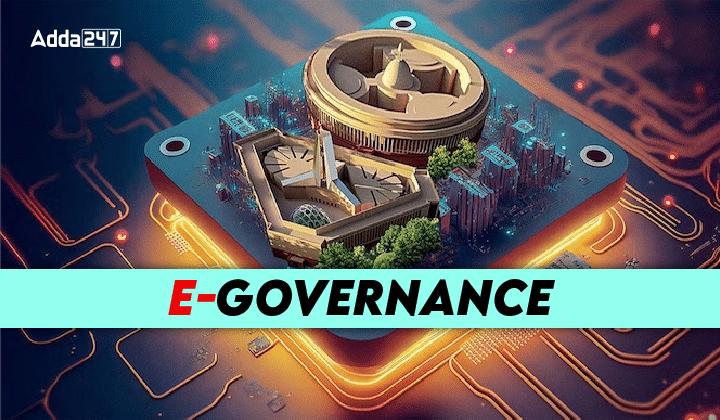Table of Contents
In a rapidly developing nation such as India, which is emerging as a global leader economically, e-governance is indispensable for both the public and private sectors. E-government, or electronic governance, utilizes Information and Communications Technology (ICT) for governmental operations.
This covers a number of programs, including the Digital India program, Aadhaar, the Common Entrance Test, the National Portal of India, the Prime Minister of India’s portal, online tax filing and payment systems, digital land management systems, and more.
e-Governance
E-governance, as defined by the World Bank, refers to the use of information technology (including mobile computing, the Internet, and wide area networks) by government agencies to transform interactions with businesses, citizens, and other governmental entities.
E-government is a stride towards SMART governance, embodying principles of straightforwardness, morality, responsibility, responsiveness, and transparency in governance.
- Simple: It refers to the application of ICTs to streamline government laws, regulations, and procedures, making government more user-friendly.
- Technology: Its interventions increase the effectiveness of law enforcement, anti-corruption agencies, and other government agencies. Moral: denoting the establishment of a completely new set of ethical principles in the political and administrative apparatus.
- Accountable: Encouraging the creation, advancement, and application of efficient Management Information Systems and performance assessment techniques, therefore guaranteeing public sector employees’ responsibility.
- Responsive: Simplifying the procedures to enhance system responsiveness and hasten service delivery.
- Transparent: Encouraging the public to access information formerly restricted to government documents and enhancing the transparency of processes and functions would help administrative agencies respond to requests for equity and the rule of law.
26th National Conference on e-Governance
From August 25 to 26, 2023, the Department of Administrative Reforms and Public Grievances (DARPG) and the Ministry of Electronics and Information Technology (MeitY) of the Government of India co-hosted the two-day National Conference on e-Governance (NCeG) at the Brilliant Convention Centre in Indore, Madhya Pradesh. The conference’s theme was “Viksit Bharat, Empowering Citizens.”
The Ministry of Panchayati Raj’s SVAMITVA (Survey of Villages Abadi and Mapping with Improvised Technology in Village Areas) Scheme was honored with the prestigious National Award for e-Governance 2023 (Gold) for its utilization of Emerging Technologies for Citizen-Centric Services.
Interactions in e-Governance
The Second Administrative Reforms Commission’s 2008 report “Promoting e-Governance: The SMART Way Forward” delineates the four categories of e-government interactions government to business, government to government, government to employee, and government to citizen.
- Government to Citizens, or G2C, is the creation of an interface between the government and the people that allows the people to take advantage of the effective provision of a wide range of public services.
- G2B (Government to Business): In this scenario, the business community can communicate with the government more easily by using e-governance systems.
- Government to Government (G2G): This type of interaction occurs only between government entities and can be vertical (i.e., between national, provincial, and municipal government agencies) or horizontal (i.e., between different government agencies at different organizational levels).
- G2E (Government to Employees): This is a two-way process in which the employee and the organization communicate.
Benefits of e-Governance
Electronic Governance is an initiative that holds numerous benefits to improve development for growth. Here are some of the e-Governance benefits mentioned to gain learning.
- Improved provision of public services by the government
- Better communication with the business and industry
- Providing information access to empower citizens
- Improved effectiveness of government administration
- Reduced corruption in the government Enhanced openness in the government
- Greater convenience for people and companies
- Revenue growth and cost reductions
- Enhanced credibility of the government Flatten’s hierarchy
- Less red tape and paperwork in the administrative process
- Improved collaboration and planning across the many governmental levels
- Increased involvement of citizens in the process of government
- Better relationships between the government and the general public
- Administrative process reorganization.
Government Initiatives
The Indian government has programs to help its citizens with things like welfare and security. Some programs are paid for completely by the central government, called “central sector schemes” (CS). Others are mainly funded by the central government but run by the states, known as “centrally sponsored schemes” (CSS).
- Health: vaccine tracker, electronic health record, Swasth Bharat app, Aarogya Setu app, Sugamya Bharat app, etc.
- Women: Mahila e Haat, the HIMMAT app, the SHe Box, the NARI portal, etc.
- Education: Swayam Prabha, National Digital Library of India, DIKSHA portal, SWAYAM, etc.
- Agriculture: AGMARKNET, Agriculture Mission Mode Project, Kisan Call Centers, etc.
- Government oversight and services include Lokvani, Aadhar, Digi Locker, UMANG, PRAGATI, e KRANTI, and Digital India.
The National e-Governance Plan (NeGP)
On May 18, 2006, the government introduced the National e-Governance Plan (NeGP), comprising eight components and 27 mission-mode projects. The NeGP aims to unite state-wide e-government initiatives under a shared vision, fostering a comprehensive approach. A nationwide infrastructure is being developed around this concept, extending to even the most remote areas, with extensive digitization of records to enable reliable internet access. The NeGP’s Vision Statement emphasizes the goal of bringing government services closer to citizens’ homes. In 2011, four additional projects—Health, Education, PDS, and Posts—were included, expanding the total number of Mission Mode Projects (MMPs) from 27 to 31.
Way Forward
- The government urgently needs to increase internal and external investment, as well as actively engage the private sector in innovation and management, particularly in the areas of technology tech giants, and civil society.
- To guarantee the best results, the 2nd ARC has also advised the state to establish appropriate chances for public-private partnerships, e-governance initiatives, reengineering of the governance mechanisms, and skill development for both building and sustaining the governance mechanisms.



 TSPSC Group 1 Question Paper 2024, Downl...
TSPSC Group 1 Question Paper 2024, Downl...
 TSPSC Group 1 Answer key 2024 Out, Downl...
TSPSC Group 1 Answer key 2024 Out, Downl...
 UPSC Prelims 2024 Question Paper, Downlo...
UPSC Prelims 2024 Question Paper, Downlo...
